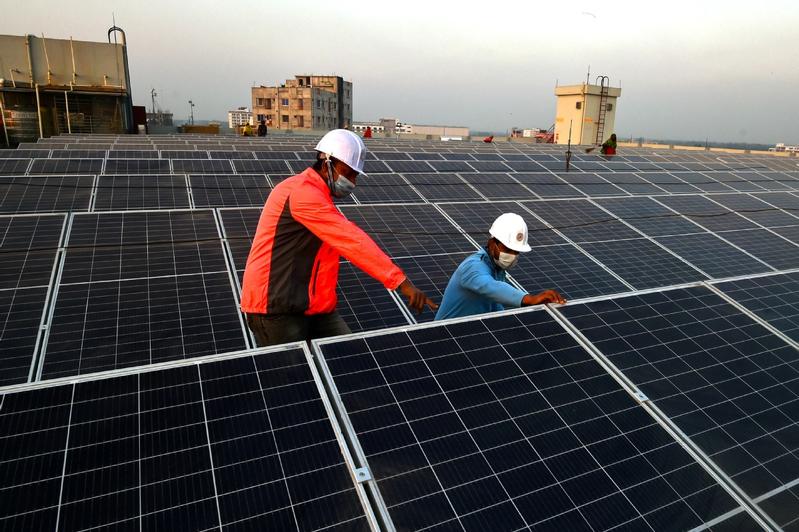 Technicians examine solar panels installed at a factory in Gazipur on the outskirts of Dhaka, Bangladesh, on Jan 3, 2021. The South Asian country is upgrading its energy networks. (PHOTO / XINHUA)
Technicians examine solar panels installed at a factory in Gazipur on the outskirts of Dhaka, Bangladesh, on Jan 3, 2021. The South Asian country is upgrading its energy networks. (PHOTO / XINHUA)
A slew of China-backed infrastructure projects, many of which are nearing completion, is bolstering Bangladesh's ambitious plans to move up the economic development ladder, analysts said.
The country has set out plans to rise up from the status of a least developed country to that of a developing nation by 2026-and cooperation with China is seen as a key enabler of this target.
Many of the infrastructure projects, including a China-funded, US$3.3 billion rail link related to a 6.4-kilometer-long bridge on the Padma River, are integrated with the China-proposed Belt and Road Initiative.
Bangladesh is counting heavily on the success of its mega-infrastructure projects that are linked to the Chinese BRI (Belt and Road Initiative).
Sirazul Islam, Executive chairman of the Bangladesh Investment Development Authority
"Bangladesh is counting heavily on the success of its mega-infrastructure projects that are linked to the Chinese BRI," said Sirazul Islam, executive chairman of the Bangladesh Investment Development Authority, or BIDA.
Bangladesh's China-financed projects include a power plant in Payra worth US$1.9 billion, a digital connectivity venture valued at US$1 billion, and a US$1.32 billion upgrade to the electricity grid.
"Once completed the Padma bridge alone will raise Bangladesh's GDP by more than 1 percent, benefiting about 30 million people in 21 southwestern districts of Bangladesh," said Fahmida Khatun, executive director of the Centre for Policy Dialogue, a think tank in the capital Dhaka.
"Not only will the bridge connect the 21 districts, it will also help them become economic growth centers. Some will emerge as new economic corridors as well," she said. "This will in turn create numerous new jobs and raise incomes."
ALSO READ: BRI-related investments bring substantial benefits for Bangladesh
With its location between China and India, Bangladesh is seen as a prime candidate to emerge as a trading and manufacturing hub.
Prime Minister Sheikh Hasina views the BRI as an opportunity for Bangladesh to make a big leap forward in its economic journey. To this end, she has signed an agreement for the establishment of an Investment Cooperation Working Group with China.
In a bid to attract more investment, the government has allocated nearly 775 acres (about 314 hectares) of land for a special economic zone for Chinese investors in the Anwara Upazila district of Chittagong. More than 60 enterprises have expressed their desire to come on board, with investments worth nearly US$280 million.
"If the promised investments in Bangladeshi infrastructure serve as an indicator, then China and the Chinese look dominant players on the investment horizon of the country," said Abdur Rahim, co-owner of Shanti Enterprises, an export-import company in Dhaka.
In 2015, China became Bangladesh's largest trade partner, Rahim noted. Three years later, China was the country's top investor. China held on to the position in 2019, with investments of US$1.2 billion.
Most of the Chinese investments have flowed into the country after a visit by Chinese President Xi Jinping in October 2016.
Islam said BRI activities gathered steam in Bangladesh after the Xi trip. "Xi's 22-hour state visit paved the way for Bangladesh to ink a number of investment deals with China," he said.
READ MORE: BRI to bring huge benefits for nations
Islam said the BRI-related projects are advancing even during the coronavirus pandemic, though he noted investment flows had been affected over the past year.
"BIDA is doing its best to keep potential investors, especially those from China, engaged through webinars and other virtual platforms. We are constantly in touch," he said.
In a big way
Islam expressed confidence that Chinese investment will soon flow into the manufacturing sector, too, in a big way.
Khatun said: "Good infrastructure defines how a country makes progress on all fronts. A bridge or a port doesn't merely mean easier communication or faster movement for people and freight. It also means that there will be more industries, more capital, more jobs, higher income and better livelihoods."
Anu Mohammed, a senior official of Bangladesh's National Committee to Protect Oil, Gas, Power, Port and Mineral Resources, said the country faces a long, hard road as it strives to take its economy to the next level.
"We all know that it's not an easy task. But if your plan is realistic and meticulous, and you play your cards well and the implementation of policy measures is effective, it is eminently achievable," he said.
Khatun said with Bangladesh strongly integrated with the BRI, the prospects for the entire region are bright.
The Padma rail project is integral to the proposed Bangladesh-China-India-Myanmar Economic Corridor, a key plank of the BRI.
Spread over 1.65 million square kilometers and inhabited by more than 450 million people, the economic corridor will connect China's Yunnan province with Bangladesh, Myanmar, and Kolkata in India via road, rail, water and air links.
Connectivity through the economic corridor has the potential to benefit northeastern Indian states through trade with Yunnan province. Bangladesh can also benefit through those linkages, Khatun said.
The writer is a freelance journalist for China Daily.


